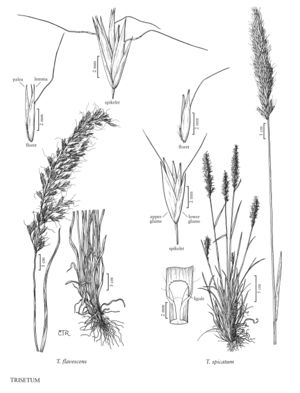Trisetum flavescens
Plants perennial, sometimes with both fertile and sterile shoots; usually cespitose, sometimes rhizomatous, rhizomes usually short, to 7 cm in sandy soils. Culms (10) 50-80 (130) cm, solitary or clumped, erect or decumbent, glabrous, sometimes scabrous or pubescent near the upper nodes. Leaves usually evenly distributed; sheaths glabrous or pilose, throats often with 2+ mm hairs; ligules 0.5-1 (2) mm, obtuse, lacerate, sometimes ciliolate, hairs to 0.5 mm; blades 5-15 (18) cm long, 1.5-4 (6) mm wide, flat or involute, lax, pubescent or pilose. Panicles 5-20 cm long, 1.5-7 cm wide, erect or nodding, glistening yellowish-brown, sometimes purple-tinged or variegated; branches 2-4 (6) cm, ascending to divergent, often flexuous, sometimes naked below. Spikelets 4-8 mm, subsessile or on pedicels to 5 mm, with (2) 3 (4) florets; rachilla internodes to 1+ mm; rachilla hairs to 1.5 mm; disarticulation above the glumes, beneath the florets. Glumes unequal, shiny; lower glumes 2.5-4.7 mm, narrowly lanceolate to subulate; upper glumes 4-7 mm long, as long as or longer than the lowest florets, twice as wide as the lower glumes, lance-elliptic, acute; callus hairs to 0.5 mm; lemmas 3.5-6.3 mm, ovatelanceolate, minutely pubescent, bifid or bicuspidate, teeth conspicuous, usually 3-6 mm, awned, awns (3) 5-9 mm, arising from the upper 1/3 of the lemmas and exceeding the apices, geniculate, tightly twisted below; paleas 3-5.5 mm; anthers 1.3-2.8 mm. Caryopses 2.5-3 mm, glabrous. 2n = 28.
Distribution
N.J., Mass., Wash., Calif., Kans., N.Y., Pacific Islands (Hawaii), Vt., Miss., Okla., Alta., B.C., N.S., Ont., Que., Mo.
Discussion
Trisetum flavescens grows in seeded pastures, roadsides, and as a weed in croplands. Native to Europe, west Asia, and north Africa, it was introduced into the Flora region because of its drought resistance, wide soil tolerance, and high palatability to domestic livestock. It is one of the few range plants known to contain calcinogenic glycosides, which can lead to vitamin D toxicity in grazing animals (Dixon 1995). This species seems not to have persisted in southern Ontario (Michael Oldham, pers. comm.). Several infraspecific taxa have been recognized; no attempt has been made to determine which are present in the Flora region.
Selected References
None.
Lower Taxa
"decumbent" is not a number.
